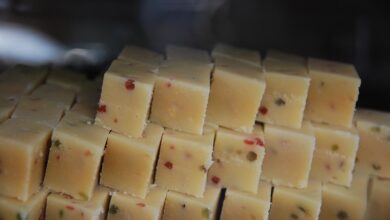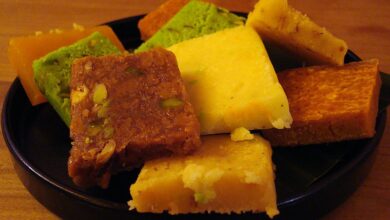How to make the best crispy jalebi at home?

What is Jalebi?
Jalebi is a popular sweet snack that is enjoyed by people all over the world. It is well known in many South Asian countries, including India and Pakistan. If you’ve never tried jalebi before, then you’re in for a real treat! This sweet, sticky snack is made by deep-frying a batter made of wheat flour and then soaking it in a sugary syrup. In this article, we’ll walk you through how to make jalebi at home step by step.
The traditional jalebi recipe calls for fermenting a mixture of all-purpose flour, gram flour (besan), baking soda, and water for several hours. After that, the fermented batter is deep-fried in concentric circles in heated oil. After that, the spirals are dipped in flavored sugar syrup and served.

Different Methods
One of two methods can be used to make jalebi. The traditional method calls for 12 to 24 hours of fermentation, which gives the batter a slightly sour flavor. I suggest you the conventional approach, which yields delicacies that taste as they came straight from a mithai shop.
The other alternative is the instant method, which involves making the batter and then frying it right away. Lemon juice or yogurt is sometimes added to the instant batter to provide the same sour flavor. If you’re short on time, this fast method of creating jalebi is convenient, but I believe it’s always better to ferment the batter. The conventional batter, in my opinion, has a superior taste and texture than the fast approach.

Instructions To Make Jalebi
Before making this homemade jalebi recipe, you’ll need to ferment the batter first. To make a smooth batter, combine the dry ingredients with the water and leave it aside to ferment.
Prepare Batter
1- Measure 1 cup of all-purpose flour into a mixing bowl. Add 2 tbsp. Besan or gram flour, a pinch of baking soda, and pinch of turmeric powder.
2- Using a spoon or spatula, thoroughly combine all of the above dry ingredients.
3- Pour about 1 cup of water. The amount of water needed varies depending on the flour quality.
4- Begin by mixing with the spatula, spoon, or wired whisk. While mixing, break up any lumps. Mixing can also be done using your hands. The batter should then be stirred quickly in round circular motions for 4 to 5 minutes. This gives the batter more volume and makes it more even, glowing, and smooth. The batter should be free of lumps.
5- Cover and leave the batter to ferment for 12 to 24 hours in a warm area. The batter will ferment in around 6 to 7 hours in a hot and humid place. In contrast, it can take up to 10 hours in a cool or frigid environment. If you over ferment the batter, it will turn quite sour and have an awful odor.
6- The next day on the top of the batter, you’ll notice tiny bubbles.
7- Mix the batter thoroughly. If you look closely, you can see that the batter has thinned slightly from before fermentation.
8- Add 1 to 2 tablespoons of all-purpose flour to thicken the batter again. At this point, add flour as needed.
9- Using a spoon or a wired whisk, thoroughly combine all ingredients.
10-Pour the finished batter into a squeeze bottle. And set it aside for now.
Alternatively, you can use a piping bag, a coconut shell with a bit of hole, or build your piping bag out of parchment paper.
Prepare Sugar Syrup
1. In a saucepan, melt 1 cup sugar. Toss in some saffron strands. Saffron, which gives the jalebis a lovely orange-yellow hue and a fragrant aroma, is highly recommended.
2. Pour in half cup of water.
3. Place the pan over low heat on the stovetop and stir until all of the sugar has dissolved.
4. Cook the sugar syrup over low to medium heat. Stir at regular intervals.
5. Cook until the sugar syrup reaches a string consistency. Touch slightly cooled drips of syrup between your index and thumb to check. When you join and pull your fingers apart, you will notice the development of a single strand of string.
6. Switch off the heat and add few drops of lime or lemon juice once you’ve achieved the one-string consistency. Stir everything together thoroughly.
Keep the sugar syrup warm by leaving it on the burner while adding the jalebi.
Fry Jalebi
1. In a heavy-bottomed Kadai or pan, heat ghee or oil for deep frying. Although ghee has a more excellent flavor, you can use a 50/50 mix.
2. To test the temperature of the oil, drop a small amount of batter into it. If it rises rapidly and steadily, the oil is hot enough to fry the jalebis.
The ideal frying temperature is three hundred fifty degrees Fahrenheit/176 degrees Celsius.
3. Squeeze the bottle and use the batter to make concentric rings.
4. Begin in the center and work your way outward, or vice versa. Because the oil is hot, be careful when cooking jalebi.
5. The jalebis keep moving while making the circles, you won’t get perfect shapes. This will take some practice, and it will also depend on your equipment to make them.
6. When one side partially cooked, and the batter has firmed up, flip it over with tongs and fry the other side.
7. Cook until the oil has stopped sizzling and the jalebis have turned a light golden color. Remove the tongs or bamboo skewer with tongs or a bamboo skewer, shaking to drain any excess oil.
8. Dip the fried jalebi into the sugar syrup right away. It should still be heated when you add the jalebi to the sugar syrup.
9. Allow them to sit in the syrup for 2 to 3 minutes. They will be mildly colored if you leave them for two minutes, and they will be darker if you leave them for three minutes or more.
10. Remove with tongs or a wooden skewer. Shake lightly to ensure that any extra sugar syrup returns to the pan. Place them on a foil or butter paper-lined dish.
Jalebi can be served hot, warm, or at room temperature. The leftovers can be stored in a fridge for up to 5 days in an airtight container.
Can jalebi be made without curd?
Yes, jalebi can be made without curd. Some people add curd to the batter to make it more tender, but it is not necessary. If you don’t have curd, you can simply omit it from the recipe.
Is jalebi Pakistani or Indian?
Jalebi is a popular sweet snack in both India and Pakistan. It is also enjoyed in other South Asian countries, such as Bangladesh and Nepal. The exact origin of jalebi is unclear, but it is believed to have been brought to India by the Moghuls.

How do you keep jalebi crispy?
Jalebi tends to become soft and soggy over time, so it’s important to serve it as soon as possible after frying. To keep jalebi crispy for a longer period of time, you can try the following tips:
Fry the jalebi just before serving.
1. Drain the jalebi well after frying to remove excess oil.
2. Soak the jalebi in the syrup for a shorter period of time.
3. Serve the jalebi on a paper towel or a rack to allow any excess syrup to drain.
Is jalebi made from dal?
No, jalebi is not made from dal (lentils). The batter for jalebi is made from a mixture of wheat flour and gram flour, with some variations including yogurt or milk.
Why is jalebi unhealthy?
Jalebi is considered unhealthy due to its high sugar content and deep-frying method. A single serving of jalebi can contain a large amount of calories and saturated fat. Additionally, the syrup used for soaking the jalebi is often made with large amounts of sugar, which can contribute to various health problems, such as obesity and tooth decay.
What jalebi is called in English?
Jalebi is known by different names in different regions, but in English, it is typically called “jalebi.”
Is jalebi good for health?
Jalebi is not considered a healthy snack due to its high sugar and calorie content. If consumed in moderation, jalebi can be a treat, but it should not be a regular part of a healthy diet.
Which country eats jalebi?
Jalebi is a popular sweet snack in many South Asian countries, including India, Pakistan, Bangladesh, and Nepal. It is also enjoyed in other countries with South Asian communities, such as the United Kingdom and the United States.
Is jalebi good for fat loss?
Jalebi is not a good food for those looking to lose weight or maintain a healthy weight. It is high in sugar and calories, and the deep-frying method used to make jalebi adds additional calories and saturated fat.
Can I use baking soda instead of baking powder in jalebi?
Baking soda and baking powder are used for different purposes in cooking and baking. Baking soda is used as a leavening agent to help baked goods rise, while baking powder is used to add a light, fluffy texture. In jalebi, the batter is not meant to rise, so there is no need to use baking soda or baking powder.
How to draw jalebi step by step?
To draw jalebi, follow these steps:
1. Draw a small, circular shape to represent the jalebi.
2. Draw another circular shape inside the first one to represent the syrup.
3. Add small, curved lines around the circumference of the jalebi to give it texture.
4. Add shading or colour to the jalebi to make it look more realistic.
How many circles are there in jalebi?
There are typically two circles in jalebi – the outer circle of the jalebi itself, and the inner circle of syrup. The number of circles can vary depending on the desired size and thickness of the jalebi.
Some Jokes about Jalebi:
How does a jalebi describe its day? It’s been a twisty and turny kind of day! 😜
Why did the jalebi call the doctor? Because it was feeling a little coiled! 😜
What did the jalebi say when it got a compliment? Thanks, I’m knot that good! 😜





